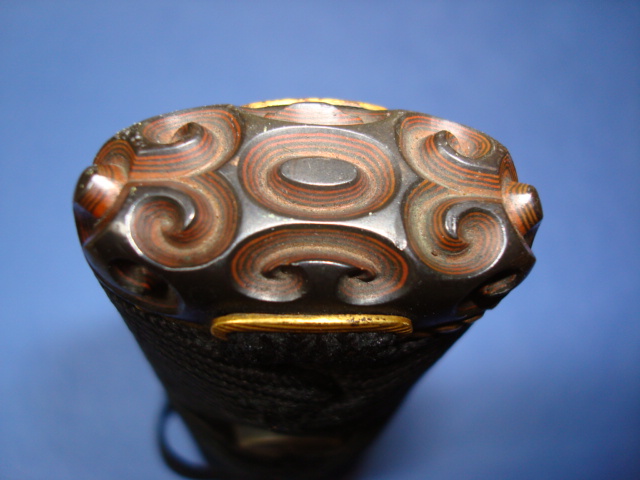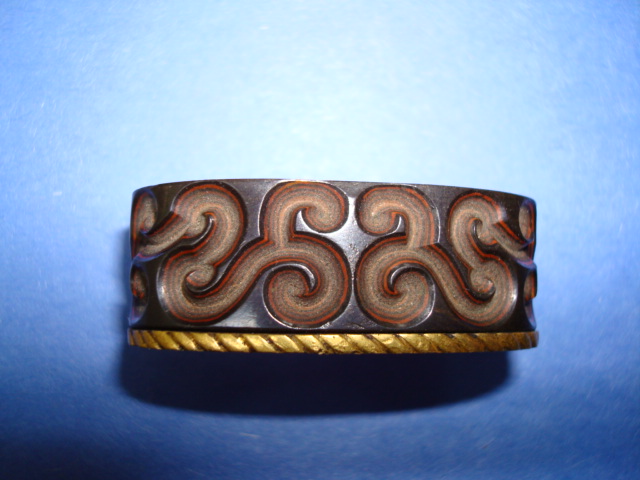
I recently received a Wakazashi from a friend. All that I know about it is that his father brought it home from Japan after WWII. I attached a photo of it partially dismantled. Can anyone recommend a place to begin in my attempt to learn more about it? Are there particular fittings that provide the strongest clues or is the blade the key?
 Attachment: 134.16 KB
Attachment: 134.16 KB


Hello Robert, and welcome to myArmoury!
That looks like a fine traditional wakizashi you have there, and not a WWII showa-to or gunto. Blades and fittings are related but distinct fields of study, and fittings and mounts can change over time, so they don't necessarily say much about the blade. In this case both the fittings and the blade look to be of good quality and either could potentially paper (i.e., win official papers of authenticity and quality from the NBTHK or NTHK expert panels).
From what I can see in the photo, everything looks to be in OK (not great, but probably not permanently messed up) condition for a WWII bringback kept by a non-collector. The very first thing I would urge you to do is to check out Dr. Stein's excellent Japanese Sword Guide; especially the Japanese Sword Care section, which will keep you from irrevocably ruining anything accidentally (Rule #1: do not touch the blade, not with polishing materials, nor your fingers). Do browse through the rest of the site, including the FAQ and Basic Visual Glossary.
I have written a brief guide to some of the basic English-language books on this subject, which you can read here: The Paper Armoury: Japanese Swords. You are welcome to check that out if you are interested in learning more about the subject in general.
As to specific help with your sword, the best place on the internet for this is the Nihonto Message Board. Many of the collectors there are far more knowledgeable that I am and if you supply them with more detail photos of the blade, the nakago (tang), the kissaki (point), the fittings, etc., will probably be able to give you a very good idea (possibly an exact statement) of when and by whom your sword was made. They will also be able to give you great advice on professional restoration and official authentication by real flesh-and-blood experts, if either seems necessary.
For my own part, I can tell you that it's a genuine and traditionally-made shobu-zukuri wakizashi in near-complete mountings - the kozuka and kurigata seem to be missing. The nakago (tang) seems to be unaltered, which is good, and the fittings and tsuka (handle) appear to be nice. I especially want to see close-ups of the fuchi and kashira, the oval collar and cap on the handle with the scrollwork, because they look very typical of guri-bori designs. Guri-bori is a technique of fastidiously layering different colored alloys, and then carving through them to produce a striped appearance. It's not especially common and it can be quite attractive.
I hope this helps you, and I look forward to seeing and hearing more of this particular sword. Congrats on a great find!
Cheers,
-Gabriel L.
That looks like a fine traditional wakizashi you have there, and not a WWII showa-to or gunto. Blades and fittings are related but distinct fields of study, and fittings and mounts can change over time, so they don't necessarily say much about the blade. In this case both the fittings and the blade look to be of good quality and either could potentially paper (i.e., win official papers of authenticity and quality from the NBTHK or NTHK expert panels).
From what I can see in the photo, everything looks to be in OK (not great, but probably not permanently messed up) condition for a WWII bringback kept by a non-collector. The very first thing I would urge you to do is to check out Dr. Stein's excellent Japanese Sword Guide; especially the Japanese Sword Care section, which will keep you from irrevocably ruining anything accidentally (Rule #1: do not touch the blade, not with polishing materials, nor your fingers). Do browse through the rest of the site, including the FAQ and Basic Visual Glossary.
I have written a brief guide to some of the basic English-language books on this subject, which you can read here: The Paper Armoury: Japanese Swords. You are welcome to check that out if you are interested in learning more about the subject in general.
As to specific help with your sword, the best place on the internet for this is the Nihonto Message Board. Many of the collectors there are far more knowledgeable that I am and if you supply them with more detail photos of the blade, the nakago (tang), the kissaki (point), the fittings, etc., will probably be able to give you a very good idea (possibly an exact statement) of when and by whom your sword was made. They will also be able to give you great advice on professional restoration and official authentication by real flesh-and-blood experts, if either seems necessary.
For my own part, I can tell you that it's a genuine and traditionally-made shobu-zukuri wakizashi in near-complete mountings - the kozuka and kurigata seem to be missing. The nakago (tang) seems to be unaltered, which is good, and the fittings and tsuka (handle) appear to be nice. I especially want to see close-ups of the fuchi and kashira, the oval collar and cap on the handle with the scrollwork, because they look very typical of guri-bori designs. Guri-bori is a technique of fastidiously layering different colored alloys, and then carving through them to produce a striped appearance. It's not especially common and it can be quite attractive.
I hope this helps you, and I look forward to seeing and hearing more of this particular sword. Congrats on a great find!
Cheers,
-Gabriel L.
Here are some better photos of the fuchi kashira that clearly show the layering that you refered to.
 Attachment: 101.5 KB
Attachment: 101.5 KB

 Attachment: 96.43 KB
Attachment: 96.43 KB



Thanks Robert, that's beautiful! Nice 8-layer work.
| Gabriel Lebec wrote: |
| Thanks Robert, that's beautiful! Nice 8-layer work. |
What layering alloys are those, do you suppose? something with copper in it, i'm guessing?
Hi Dustin,
Guri-bori originally emulated Chinese armour lacquer patterns of red and black layers, so yes, yamagane (Japanese red copper) is often used. This kind of copper patinates to a luscious deep red color, which you can see on many late-Edo kinko tsuba. I don't know what aspect of its composition, or what agent used for the patina, causes this color.
The black layer is often shakudo although here I think it might be shibuichi; difficult to tell how deep a black it is given the glare in the photo. Guri-bori can be done in any number of combinations of alloys although the shakudo/copper mix is most common.
Guri-bori originally emulated Chinese armour lacquer patterns of red and black layers, so yes, yamagane (Japanese red copper) is often used. This kind of copper patinates to a luscious deep red color, which you can see on many late-Edo kinko tsuba. I don't know what aspect of its composition, or what agent used for the patina, causes this color.
The black layer is often shakudo although here I think it might be shibuichi; difficult to tell how deep a black it is given the glare in the photo. Guri-bori can be done in any number of combinations of alloys although the shakudo/copper mix is most common.
Page 1 of 1
You cannot post new topics in this forumYou cannot reply to topics in this forum
You cannot edit your posts in this forum
You cannot delete your posts in this forum
You cannot vote in polls in this forum
You cannot attach files in this forum
You can download files in this forum
All contents © Copyright 2003-2006 myArmoury.com — All rights reserved
Discussion forums powered by phpBB © The phpBB Group
Switch to the Full-featured Version of the forum
Discussion forums powered by phpBB © The phpBB Group
Switch to the Full-featured Version of the forum